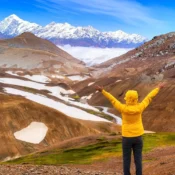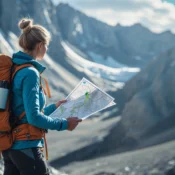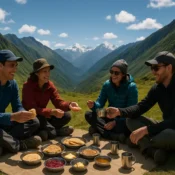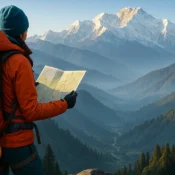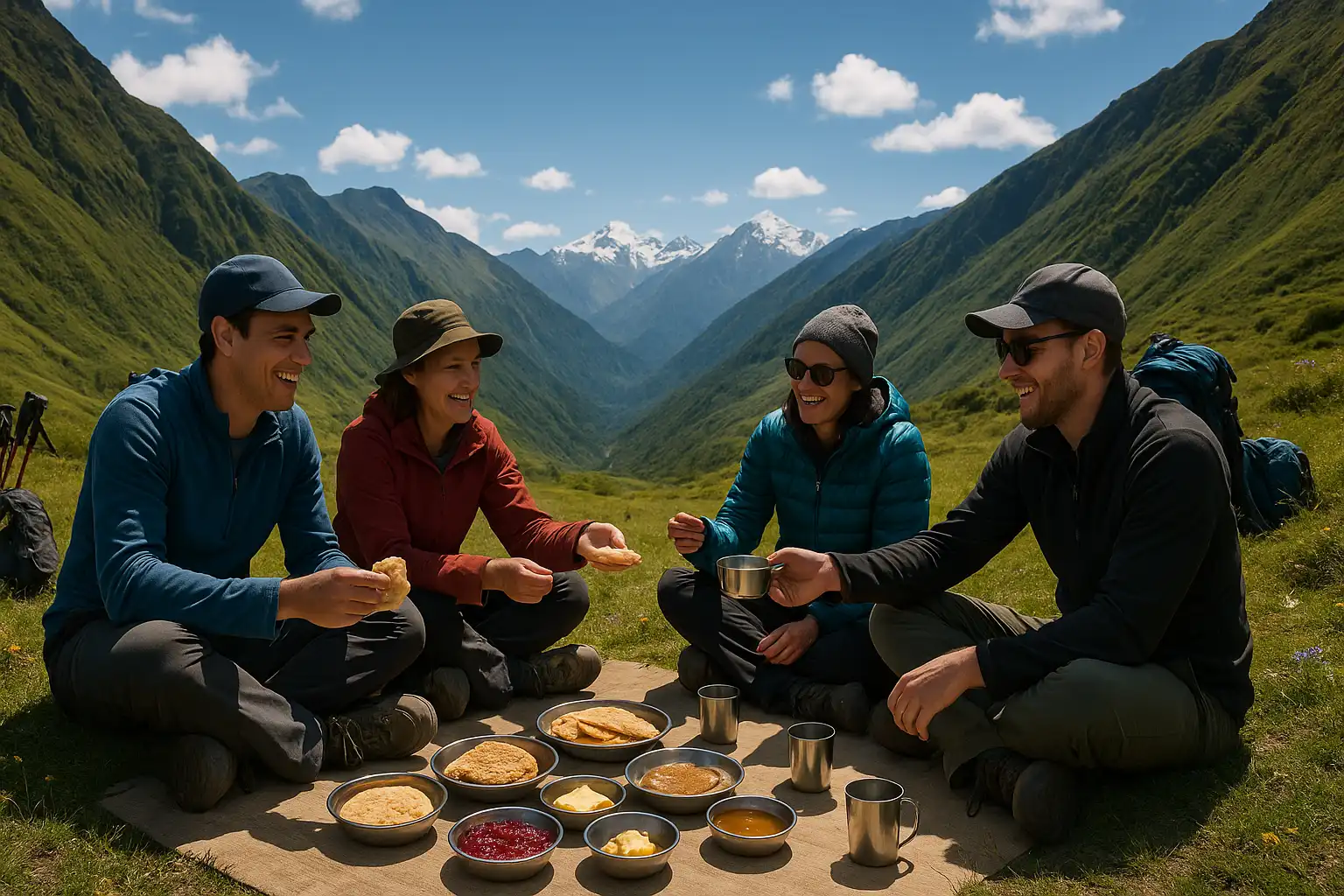
Meal Information for High-Altitude Treks in Sikkim:
High-altitude treks in Sikkim are remote adventures, where trekkers must rely on the expertise of cooks and staff for daily sustenance. Proper meal planning and hydration are foundational to a successful, safe, and enjoyable trek. This guide details what you can expect regarding meals, the rationale behind menu choices, and essential information about water provision.
Meal Planning on Sikkim’s High-Altitude Treks
How Are Meals Arranged?
- Logistics: Once trekking commences beyond the last village, all food supplies are carried by the support team, usually with pack animals or porters.
- Preparation: Dedicated cooks, often with years of mountain experience, prepare fresh, wholesome meals at each campsite, using ingredients pre-arranged by the tour operator.
- Schedule: Meals are planned meticulously to accommodate trekking schedules and provide restorative nutrition at high altitudes.
A typical day’s meal schedule:
| Time | Meal Type | Description |
|---|---|---|
| Early Morning | Bed tea/Herbal tea | Served in tents to help start the day gently. |
| Breakfast | Full meal | Porridge, bread, omelette, pancakes, etc. |
| Midday | Lunch | Rice, dal, chapatis, mixed veggies, noodles |
| Afternoon | Tea & Snacks | Soups, tea/coffee, popcorn, biscuits |
| Evening | Dinner | Multi-course meal: soup, rice, pasta, etc. |
| Night | Light Snack | Sweet dish, herbal tea |
What Meals Are Included?
Breakfast Selections
- Porridge, cornflakes, pancakes, rotis, bread-omelette, fried rice, and occasionally local delicacies
- Hot beverages: tea, coffee, sometimes hot chocolate
Lunch & Dinner Offerings
- Rice, dal (lentil soup), chapati or bread, a variety of freshly sautéed vegetables
- Pasta or noodles (e.g., chowmein, macaroni)
- Light snacks like momos or sandwiches in some camps
- Soup served before dinner; garlic soup is popular to help counter altitude sickness
Snacks
- Mixture of local and universally familiar snacks: biscuits, pakoras, French fries, dry fruits, nuts, and popcorn
- Popcorn and garlic soup especially are often highlighted for their acclimatization benefits
Special Considerations
- Sweet dish (e.g., rice pudding, fruit salad, custard) served after dinner
- Dietary restrictions (vegan, Jain, gluten-free) can often be accommodated if informed in advance
- Food is predominantly vegetarian
Why Is Meat Not Provided at High Altitude?
Scientific & Practical Reasons
- Digestion Challenges:
Protein from meat is harder to digest at high altitudes, where lower oxygen levels already stress the digestive system. Undigested proteins can lead to discomfort, indigestion, and even altitude-related health issues. - Quick Energy Needs:
Trekkers need quickly available energy from carbohydrates rather than slow-release proteins. Meals are therefore heavily geared towards complex carbs like rice, breads, and pasta for sustained energy. - Health & Safety:
Meat is highly perishable and difficult to store safely in remote, cold environments. Without proper refrigeration, the likelihood of foodborne illnesses rises, turning fresh meat into a potential health risk during extended treks. - Ethical & Environmental:
Local traditions and restricted logistics in national parks often discourage or prohibit the slaughter or transport of meat in high-altitude zones.
What is provided instead?
Nutrition is supplemented with plant-based proteins (dal, beans, chickpeas) and eggs for those who request them, balancing energy needs with digestive comfort.
Water Intake and Provision on High-Altitude Treks
How Much Water Do You Need?
- Recommended Intake: 3–4 liters per day is ideal at high altitudes.
- Hydration Frequency: Drink small amounts regularly—do not wait to feel thirsty. Dehydration can be an early trigger of altitude sickness.
How Is Water Provided?
- Source: Most camps utilize abundant mountain streams or glacial rivers—these are filtered or boiled by the staff before distribution.
- Provision Process:
- Water is boiled for at least 3 minutes at high altitudes to ensure safety.
- Some teams filter and/or treat water with purification tablets if sources are questionable.
- Trekkers should carry personal water bottles (1–2 liters) or hydration packs for easy access while walking.
- Electrolyte drinks or ORS may be provided or can be added to maintain mineral balance, especially to compensate for sweating or cold.
Extras:
- Limit consumption of caffeine and alcohol, as both can dehydrate you faster at altitude12.
- Fresh fruits with high water content (e.g., oranges, cucumber) may be offered when available to support hydration.
Sample Menu: Typical Day on Goechala / Dzongri Trek
| Meal | Possible Items |
|---|---|
| Breakfast | Porridge, omelette, bread, pancakes, tea/coffee |
| Lunch | Rice, dal, mixed vegetables, chapati, salad |
| Snacks | Biscuits, pakora, popcorn, soup, tea, garlic soup |
| Dinner | Soup, rice or pasta, vegetables, momos, sandwich, dessert |
| Hydration | Boiled/filtered water, herbal teas, electrolyte solutions |
Final Tips for Trekkers
- Inform your operator in advance if you have dietary restrictions so the cook and logistics team can prepare accordingly.
- Practice drinking more water before your trek—carry reliable bottles or hydration systems.
- Stick to the provided menu: The carefully curated vegetarian meals will keep you better acclimatized, healthier, and more energized for the unique adventure Sikkim has to offer.
Staying nourished and hydrated is one of the most essential factors to making your Sikkim high-altitude trek safe and memorable!
Welcome to the official blog of Himalayan Exposure Tours and Treks, premier travel agent in sikkim. Founded by a passionate local expert, the company is recognized and registered by the Government of Sikkim. With a deep understanding of the region and a commitment to authentic experiences, we specialize in crafting personalized journeys—from high-altitude treks to comprehensive package tours in sikkim.
Recent Posts
Himalayan Exposure Tours & Treks0 Comments
Altitude Sickness: how to prevent while trekking in Sikkim high points
Himalayan Exposure Tours & Treks0 Comments
Best Time to Visit Sikkim: Seasonal Guide for Travellers, Trekkers & Photographers
Himalayan Exposure Tours & Treks0 Comments
Meal Information for High-Altitude Treks in Sikkim:
Himalayan Exposure Tours & Treks0 Comments

